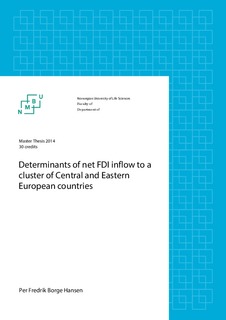| dc.description.abstract | Foreign direct investment (FDI) can provide necessary capital to enhance economic growth in transition economies and support stabilization efforts. Net FDI inflows into Czech Republic, Estonia, Hungary, Latvia and Poland from their respective 15 major investment-countries during 1996-2012, were analysed by constructing a panel data set and employing a Hausman-Taylor estimation method, treating the countries’ GDP and Wage as endogenous variables. In an attempt to create a proxy of an average Central and Eastern European country (CEEC), there was also conducted an analysis on the five countries as a cluster, using the aggregated average of their respective variables. Disaggregated sector-specific FDI inflows also allowed for a LSDV model in the search of patterns of comparative advantages through sector-preferential foreign investments.
Host country GDP, or market size, proved to have a negative effect on FDI for Czech Republic (CZ) and Poland, but a positive effect for the cluster. Source country GDP was presented as positive for CZ, Estonia, Hungary, Poland, and for the cluster. Latvian FDI inflows were positively affected by its governance indicator and that the source country is a member of the EU. CZ FDI inflows are affected positively by wages, the level of domestic investment and if the partner is a EU member, it was however affected negatively if the partner has a high level of domestic investment at home. Estonian FDI inflows are decreased if the source country is located far away and, in that, positively affected if the source country is a member of the EU. The cluster results suggest that the average CEECs would attract more FDI inflows by improving infrastructure and their openness to trade.
Based on the theory of rational investors seeking higher rate of returns in the most efficient and profitable sectors, the sector-preferential FDI inflows suggest that CZ and Poland could display patterns of comparative advantage in the Manufacturing sector. | nb_NO |
